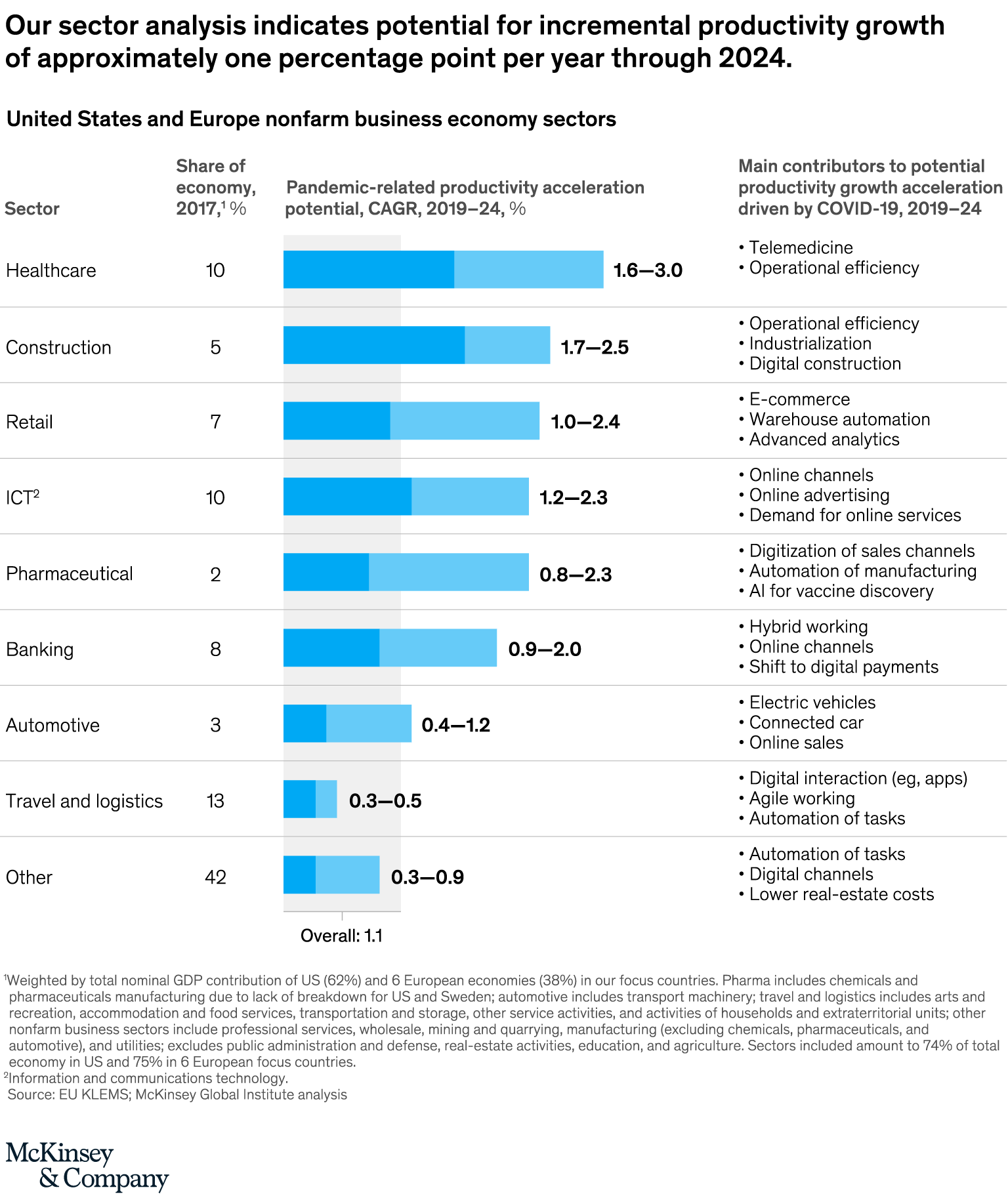Global productivity growth could increase by at least one percent in the period to 2024, so long as reskilling and upskilling efforts as part of a lifelong learning keep up, according to a study by the New McKinsey Global Institute (MGI).
The COVID-19 pandemic has led to one of the most disruptive economic periods since World War II. But despite pressures and uncertainty, many leaders and organizations across the globe pivoted swiftly to online channels and automated production processes. The decision sped up decision making processes and helped support productivity.
It’s this swift response that could more than double the rate of annual productivity growth to 1 percent in the period to 2024, according to the new study by MGI. The MGI research explored productivity growth potential in the United States, France, Germany, Italy, Spain, Sweden, and the UK, concluding that a 1% growth acceleration could drive an increase in per capita GDP ranging from about $1,500 in Spain and about $3,500 in the United States.
The largest potential incremental rise in productivity growth over this period? That would happen in the healthcare, construction, ICT, retail, and pharmaceuticals sectors. But realizing this potential will involve a heavy dedication to reskilling, upskilling, and lifelong learning.

Digitization and Automation
The research explores the potential path ahead for productivity growth to 2024 in the United States and six large European economies—France, Germany, Italy, Spain, Sweden, and the United Kingdom. Together, these seven economies account for 40 percent of global GDP. Eight sectors are examined in depth that, on average, for around 60 percent of the nonfarm business economy, as well as five additional sectors accounting for 40 percent of the nonfarm business economy for which relevant trends are extrapolated from the eight focus sectors.
More than 60% of the productivity potential will come from improved efficiency of digitization and automation, according to the MGI study. With the right conditions, this new use of technology has a chance to raise productivity.
The 2020 McKinsey Global Economic Conditions survey of executives found that 51% in North America and Europe had increased investment in new technologies, while another survey found that companies were digitizing activities 20 to 25 times faster than previously thought possible.
However, to sustain this productivity growth on a much larger scale, organizations will need to transform their entire supply chains and ecosystems. That will involve implementing new policies for public procurement focused on innovation, direct R&D investment, and product and labor market regulations.
Why Skills Are Important to Growth And Productivity
The pandemic had a measurable impact on workers’ skills and productivity. As a result of lockdowns, some workers were out of the labor force for months. MGI research revealed that around 60% of the estimated productivity potential in the future comes from growing digitization and automation, which will lead to a reduction in labor and other input costs.
But if these productivity gains are not reinvested in growth that drives jobs and incomes, they could lead to a widening gap between productivity and median wage growth as well as rising unemployment.
Jobs are changing, and the very nature of increased digitization creates a demand for people with different types of skills to fill those jobs. There is a strong business case for reskilling and upskilling existing employees. Companies can save as much as $116,000 over three years compared with the $30,000 costs of employing a new high-skilled worker, according to a study commissioned by GA. So it's no surprise that investing in reskilling will be an important element to growing productivity globally.
At the World Economic Forum’s Annual Meeting in January 2020, the Reskilling Revolution initiative was first launched. The initiative will provide one billion people with better education, skills and jobs by 2030. Speaking at the 2021 World Economic Forum’s ‘Skilling the Global Workforce’ panel in January, Adecco Group’s CEO Alain Dehaze described the continued upskilling and reskilling as crucially important, given that people are losing some 40% of skills every three or four years.
Building a Resilient Workforce For The Future
Protecting and improving the lives of workers also involves securing their ability to remain active in the workforce. It’s not just about social fairness: it’s also about protecting the wider economy. Ensuring that all workers can benefit from a framework of social protection - a new social contract - will help to offset some of the financial repercussions of the pandemic and avoid a major slump in economic demand.
The transition towards the green economy adds further strength to the case for constant reskilling, as Adecco Group’s ‘Skills for a Green Economy’ white paper found. Achieving ambitious net zero targets across all areas of industry while maintaining strong economic and productivity growth will rely on highly skilled individuals driving digital transformation across business processes. Success will depend on close cooperation and collaboration between governments, businesses, and individuals to encourage the lifelong learning that equips workers with the skills needed to achieve global productivity growth potential.



